How to Really Use an Instant Pot and Other Multi-Cookers
An analysis of the most useful functions on the Instant Pot and other multi-cookers.
The Instant Pot's ascendance was so sudden, so swift, so far-reaching, and so utterly dominating that it's hard to think of another kitchen product in recent history that has so thoroughly cornered the market.
Before the Instant Pot, when I tried to convince people that a pressure cooker was worth buying, their eyes would glaze over. But ever since the Instant Pot took off so explosively, it seems nearly everyone owns a pressure cooker, even if half of them don't seem to realize it.
And that, really, speaks to the power of the Instant Pot. People own them, people love them, and people often have no idea what they even are. So let's set this straight: "Instant Pot" is a brand name for a multi-cooker, and a multi-cooker is basically an electric pressure cooker with a few bells and whistles thrown in for good measure.
What Is a Multi-Cooker?
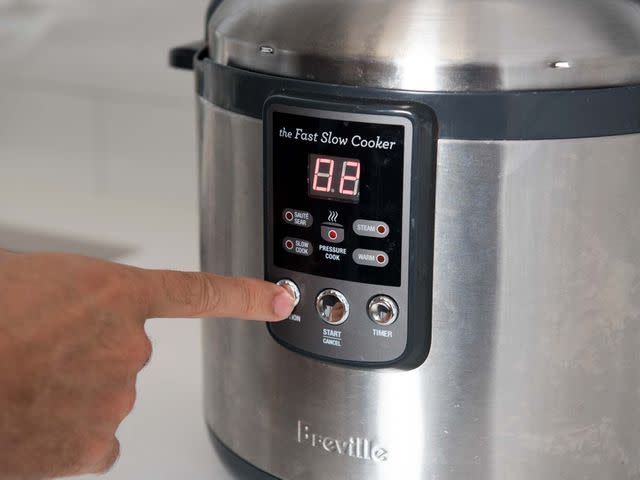
Serious Eats / Liz Clayman
If you own an Instant Pot, what you really own is a multi-cooker. If you don't own an Instant Pot, but have been debating whether or not to pick one up, you should know that there are many other multi-cooker brands on the market, some of which are worth considering (see below for our top picks).
A multi-cooker usually includes a base unit, where the control panel and heating element live; an insert, which holds the food itself and can be removed for easy cleaning; a lid with a gasket and valve, for pressure-cooking; and various accessories, like measuring cups and a steaming basket, depending on the model.
As the name implies, what's most appealing about a multi-cooker is the range of cooking options it offers. It steams! It sears! It simmers! It cooks beans! It cooks rice! It cooks stews! It cooks chili! It makes yogurt! It's a pressure cooker! It's a slow cooker! It can make my bed and clean my toilet and rub my feet and sanitize my dentures! All! In! One!
Do you know how we know it can do all those things? Because it has buttons on the front that tell us so!*
*Okay, I lied; it won't sanitize your dentures. But man, does a multi-cooker make a mean bed.
Let's cut through this noise. A multi-cooker is really just a couple of things, plus a whole lot of preset modes. It is, in the simplest sense, an electric pot; its lid has a gasket that can seal the pot shut to trap steam and build pressure, and the cooker has sensors in it to automatically control heat and pressure as needed.
Given this, a multi-cooker is really just:
A pressure cooker. This is its primary function; not only is there usually a manual pressure-cooking option (all of our recommended cookers offer one), but most of the specialized modes on a multi-cooker (rice, beans, stews, chili, et cetera) are also just pressure-cooking modes with preset times and pressure levels.
An electric pot. When the lid isn't sealed, the multi-cooker can work like any pot, whether you use it to steam foods or to sear them before stewing or braising.
A slow cooker. The multi-cooker can hold its contents at a low enough temperature that it also doubles as a slow cooker. There is rarely a reason to use this function, as I'll explain below.
A yogurt maker. The multi-cooker's ability to hold very low temperatures means that, along with acting as a slow cooker, it can also be used to incubate yogurt.
Which Is the Best Multi-Cooker?
We've reviewed pressure cookers before—both stovetop models that are strictly pressure cookers, and multi-cookers, which are primarily pressure cookers that can also perform some other tasks. You can read our full review of pressure cookers and multi-cookers to learn more, but the quick answer is that our top pick is the Breville Fast Slow Pro, while our favorite budget pick is the Instant Pot DUO.
What Are Multi-Cookers Really Good For?
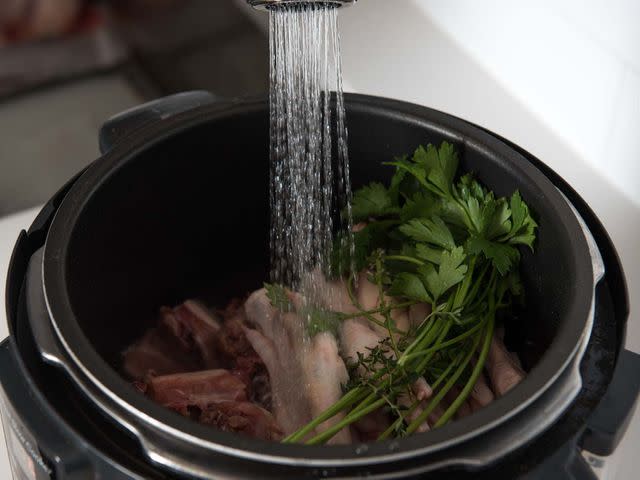
Serious Eats / Liz Clayman
So, now that we've roughly defined what an Instant Pot and other multi-cookers really are, and which are our favorites, let's briefly go over what they're truly good for, and which features you should just forget about.
Pressure-Cooking and Preset Pressure-Cooking Programs (for Rice, Stew, Stock, Soup, Et Cetera)
By far the most important feature of a multi-cooker is its ability to function as a pressure cooker. Frankly, if everyone would stop calling these things "Instant Pots" and start calling them "electric pressure cookers," there'd be a whole lot less confusion over what this device is really all about.
A pressure cooker is able to drastically reduce the cooking times of many long-cooking foods by raising the internal pressure of the chamber; as the pressure rises, so does the boiling point of the water inside. At sea level, water boils at 212°F (100°C), and it will not exceed that temperature until there's little to no available water left. When you raise the pressure, the water temperature can go higher, to around 250°F (120°C); at elevated temperatures, tough meats tenderize, and beans cook through in a fraction of the time.
Braises, like Kenji's pork chile verde, that would traditionally take two, three, or four hours are done in 30 minutes to an hour. Beans, which can take anywhere from 30 minutes to two hours on the stovetop, can be done in 10 to 20 minutes in a pressure cooker. It's an incredibly powerful tool, with jaw-dropping results. You can literally get home from work and have a stew on the dinner table in an hour from start to finish, something that is impossible with more conventional cooking methods.
Most of the settings on a multi-cooker are really just pressure-cooker presets: bean mode, rice mode, chili mode, stew mode, soup mode, poultry mode, meat mode, risotto mode, stock mode, and multigrain mode, for example. They can be helpful, but they can also be maddening.
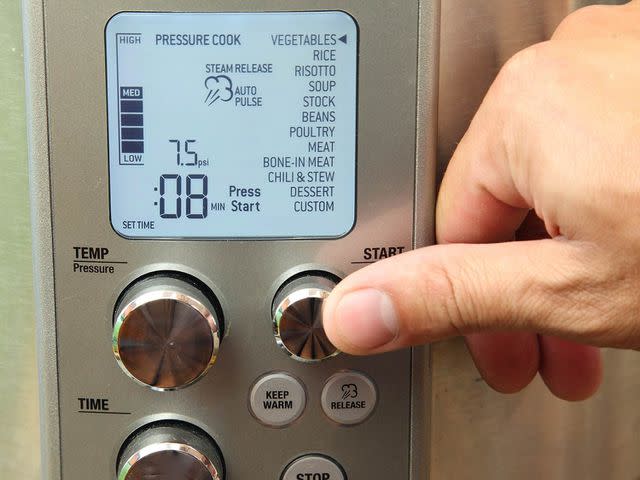
Serious Eats / J. Kenji López-Alt
If you're totally new to pressure-cooking and are not following a trusted recipe, the presets are useful in that they can give you some shot at getting results that are good, or at least put you in the ballpark. But those settings are just as often confounding, because there are enough variables to render them useless.
The Instant Pot's promise of perfect rice every time sounds great: Rice mode can supposedly detect moisture levels and then make real-time adjustments to the heat and pressure levels accordingly.
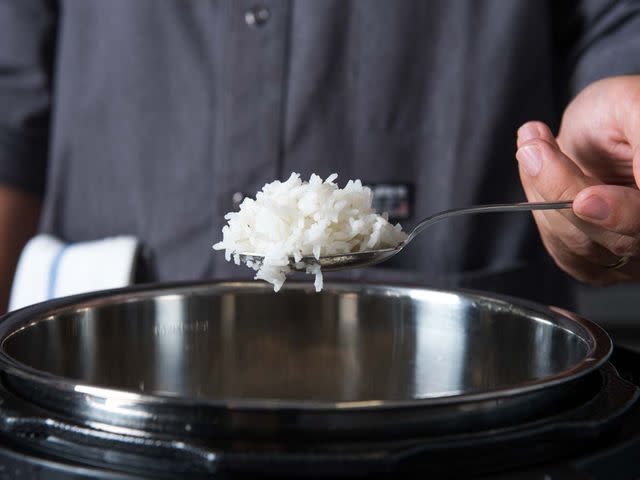
Serious Eats / Liz Clayman
But the reality is a little different. The preset is designed to work only with basic white rice; several other types of rice require a manual setting. And that doesn't include factoring in your elevation if you live well above sea level, the type of water you use, personal preferences for doneness, and more. Unless you eat only one type of rice and just happen to like it exactly as the Instant Pot preset produces it, you'll soon be overriding the preset and using a manual setting instead.
This is true of all the other preset pressure-cooking modes as well. Variations in recipes, in ingredients, in local conditions, and in your desired results will all play into the time, pressure, and temperature levels you choose; often the recipe itself will be the best guide for what settings to choose. Plus, if you set those parameters manually, you'll have a better understanding of what works and what doesn't, which is far better than not understanding why a preset mode didn't produce the results you wanted.
Beyond variations in specific recipes, multi-cookers themselves also vary from one to the next. There's no overarching standard that ensures that "high pressure" mode on one cooker is the same as "high pressure" mode on another (although those should be close—somewhere in the 12- to 15-psi range). There's also no standard that ensures one machine's meat mode is the same as another's. Ditto all the other preset modes.
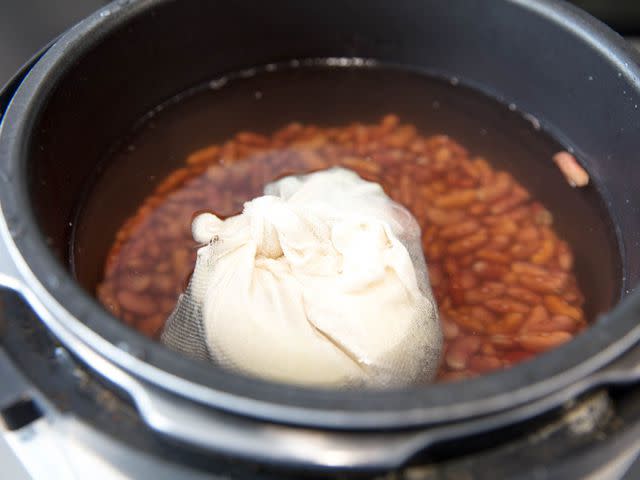
Serious Eats / Vicky Wasik
What this means is that if you live and die by the presets, you really only know how to cook with the specific model of multi-cooker you've grown familiar with. Buy a new multi-cooker one day, and you'll have to relearn its preset quirks all over again. Using the manual mode means you're more clued in to what pressures and times the cooker is actually using, parameters that are more consistent across models and brands. That makes you a more informed cook, and a more informed cook will have a better track record of success.
But this doesn't mean that the special pressure-cooking modes do nothing. According to Instant Pot, for example, the cooker uses sensors to manage heat, pressure, and temperature.
Steaming mode, for instance, lets the heating element rip full blast, since there's no risk of scorching the water on the bottom of the pot. (Foods being steamed should be held aloft in a steamer basket.) For modes that cook thicker dishes, like chili and porridge, the cooker reduces the intensity of the heating element to reduce the risk of foods burning on the bottom.
It's a nice feature if near-total hands-off cooking is very important to you. But you can also avoid burning your food just as easily by bringing the contents of the cooker to a boil with the lid off, stirring frequently to keep the food from sticking to the bottom. Once the contents have reached a boil, put the lid on and allow the cooker to finish coming up to pressure. Once it's at pressure, it doesn't take a lot of additional heat to keep it there. This is how you prevent scorching in a stovetop pressure cooker, and it works fine.
Steaming
This is one of those modes that work well, but aren't all that useful unless you're short on pots and stovetop space. In steaming mode, you simply add some water to the multi-cooker insert; add a steaming rack of some sort (included or not, depending on the multi-cooker model); and then turn the machine on. Set to steaming mode, it will crank the heating element to full blast, working to get the water boiling as quickly and relentlessly as possible, in order to produce enough steam to cook whatever it is you're cooking. The lid can go on to contain the steam, but it won't lock—locking would fully trap the steam, leading to pressure-cooking.
There's no reason not to use this setting, except that you can just as easily steam foods in a wok or pot set over a stovetop burner. Unlike the pressure-cooking mode, which offers dramatic performance differences compared with traditional stovetop methods, the steaming mode on a multi-cooker is just like any other steaming setup.
Searing
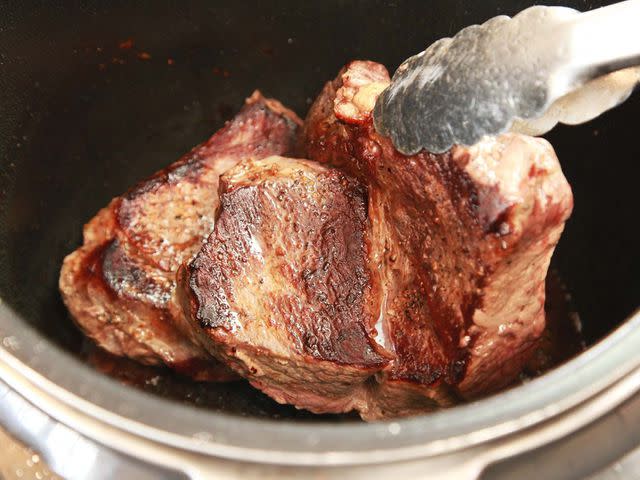
Serious Eats / J. Kenji López-Alt
Many braise and stew recipes call for browning meats and aromatics before adding the liquid, since browning develops a layer of flavor that can transform whatever you're cooking from good to great. This makes the searing mode in a multi-cooker very important, but it has its limitations.
In my experience, a multi-cooker doesn't sear nearly as well as a Dutch oven or stainless steel pot set over a stovetop burner. Multi-cooker inserts tend to be tall and narrow, with a small footprint for the bottom of the pot, and the heating element gets only so hot. This can be a problematic combination, making the multi-cooker prone to overcrowding and thus steaming your food when you want to be searing and browning it.
You can make it work by searing ingredients in very small batches, and by waiting longer for trapped moisture to cook off and true searing to begin, but it's certainly not the strong point of any multi-cooker I've ever used. It's fine for making a stew or braise from start to finish all in the same multi-cooker pot, but I'd never use a multi-cooker to sear foods that don't otherwise require being in the multi-cooker.
Slow-Cooking (With Major Reservations)
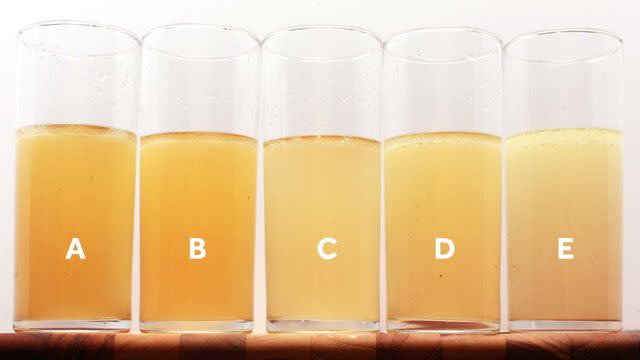
Serious Eats / J. Kenji López-Alt
This is one of the other top selling points of the multi-cooker: It's a slow cooker, too! But, as any cook worth their salt knows, a slow cooker isn't really worth its salt.
Yes, they can be left unattended for hours, and even days, with relatively little risk. But with their low cooking temperatures, the food they make is never as good as dishes produced by more traditional stewing and braising methods. Nor are a slow cooker's results as good as those achieved in a pressure cooker, which can make a better version of the same dish in a tiny fraction of the time. You can learn more in our comparison of slow cookers and pressure cookers.
There's really no contest. In almost all instances, you should be using the pressure-cooker mode, not the slow-cooker mode.
Yogurt
Similar to the way a multi-cooker uses low heat for the slow-cooker mode, it can use even lower heat to incubate yogurt. Many models will scald the milk first (a common first step in yogurt-making), then switch over to incubation mode.
Does it work?
Yes, indeed it does, though it's not as hands-off as multi-cooker manufacturers make it seem. You still need to monitor the temperature of the milk using a separate instant-read thermometer, especially when the milk is cooling, since you can kill your starter and ruin your batch if you add it to milk that's too hot. This is, once again, one of those situations in which the multi-cooker works, but it doesn't save you much effort compared with scalding the milk on the stovetop.
As for incubating the yogurt, which requires holding the temperature somewhere around 110 to 115°F (43 to 46°C), the Instant Pot I tested seemed to do a serviceable job, in that the yogurt successfully set (a sign that the milk never overheated during the incubation phase). I wasn't able to monitor the temperature of the milk the entire time, so I'm not quite sure just how much it may have fluctuated, but it clearly didn't fluctuate too much given the results.
What I do know from my initial yogurt testing is that the Instant Pot I tried produced my least favorite yogurt of the bunch—the yogurt ended up set, but it seemed fragile, and it separated into curds and whey easily. It also had a strange metallic flavor, which I haven't yet been able to explain.
It's possible that, with more testing and tweaking, I can find my way to better yogurt results using the Instant Pot or another multi-cooker. But I also know from my testing that there are other methods that work very well, including using an immersion circulator, or just going the old-fashioned route of leaving the yogurt in an oven overnight, with the oven light turned on. (After this article was published, I wrote a guide to making yogurt that goes into more detail on my favorite methods.)
So, do you need an Instant Pot or other multi-cooker? If you don't own a pressure cooker already, then yes, there's a strong argument to be made for it, because I think all cooks will find a pressure cooker to be a very useful addition to their lives. And if you're often short on stovetop space, having a stand-alone unit can be incredibly useful.
If you have no interest in pressure-cooking, though? Skip it, because that's all a multi-cooker really is.

